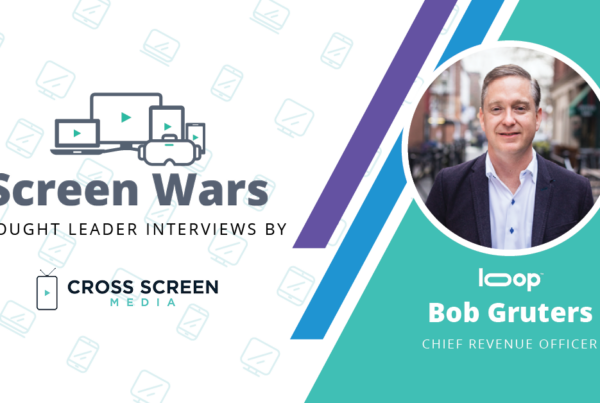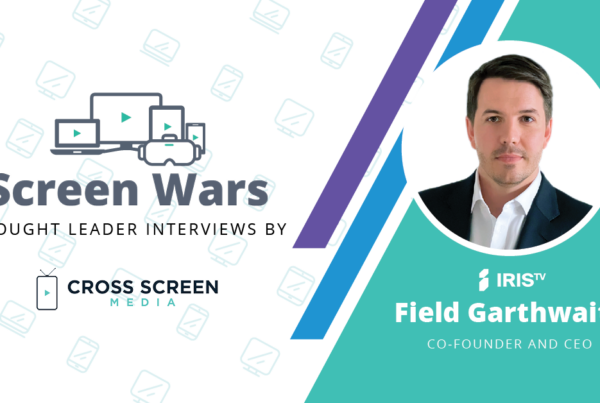Professor Karen Nelson-Field, Amplified Intelligence’s Founder and CEO, joins Cross Screen Media CEO Michael Beach to shares her expertise on the “Attention Economy” and its effects on measuring media today in our latest Screen Wars Thought Leader Interview. Watch the interview here and read the full transcript below.
Michael Beach: Karen, welcome to the show.
Professor Karen Nelson-Field: Thanks for having me.
MB: Well, let’s start off with an icebreaker today. We ask every one of our guests, what was your first job and what lessons did you take away from it that you applied to your career?
KNF: Goodness, that was a while ago. My very first job straight out of school was retail. I worked in a newsagent. I vividly remember how people would line up and come and pick up their newspapers. In particular, in our city, newspaper subscriptions had around 70% of the population getting a newspaper delivered, or the local news core paper delivered every day. And that a lot of them would wait at the front and line up for it.
I remember thinking, at the time, I’m thinking, “Gosh, this whole quality media,” I probably didn’t think of it in those days in my teens, but the whole quality media piece is valuable. People are lining up and paying for the experience of whatever’s in this paper. So I remember thinking, “Wow, that’s pretty impressive.” That’s one of the lessons, and there are others that I probably shouldn’t tell you.
MB: Absolutely. Well, how’d you get your start in the media space?
KNF: I’ve always had a passion for it and was a late bloomer academically. I went quite quickly once I’d started doing university, but I didn’t go to uni straight after school. I had a few years where I was just experimenting with marketing or retail or whatever was coming along. I remember landing a job for cinema sales and, if you’ve ever done door-to-door cinema ad sales, that is real-world experience. You’re walking on main roads knocking on doors saying, “Would you like to advertise in the local cinema?”
I started with that, but the concept of advertising and marketing always fascinated me. I remember thinking, and this must be related to my experience in the newsagent, that my absolute ultimate job would be working for News Corps. I’m from Adelaide, so it started here.
I also remember going and getting Ogilvy On Advertising and trying to understand how advertisers were. I don’t know that you’d get that from that book, but any time a little ad would come up for a sales rep in the advertiser or the Sunday mail, which are the papers here [ in Australia], I would apply for it. Eventually, I got one and I got to management fast and I’m told, was the youngest ever advertising sales manager in history.
MB: That’s fantastic. Before we jump in any further, would you give us a sense of the team at Amplified Intelligence and what problem you’re solving?
KNF: The team is very interesting. We started about five years ago and there are probably about 15 of us now. After working in media as a young girl and I worked for Diageo as a premium brand manager. I did the Johnny’s and the Stolichnayas and all that sort of stuff. After working on the brand side, I made a decision. By then I’d already done a few degrees and I made a decision to do a Ph.D.
I did my Ph.D. in media, and I stayed there for a while because the path that I took, led to me becoming enamored by these new (at the time) things like Facebook and YouTube. My research started to morph way from legacy platforms and more into, “How does the concept of brand growth apply in new media?” Obviously, that catapulted me because I was in the right place, at the right time.
Five years ago, after technically being a lecturer/associate professor, and then eventually a professor, I was very frustrated by the, A, lack of ability to move fast in an academic world and by, B, observing that the whole concept of legacy metrics was becoming quite an issue. Quite frankly, I saw an opportunity to develop technology, to answer questions that old-fashioned methods couldn’t and still can’t.
We’re a small team, but we punch above our weight and there’s a mix of research. I left the university to build a research business, but we’ve quickly morphed into a technology business. And now we have a SaaS platform. So essentially, what we do is we solve the problem that not all reach is equal and the current proxies that are out there don’t cut it. We solve for the problem that CPM doesn’t. There’s no way that advertisers can tell the relative value between platform A and platform B. That’s the problem we solve.
We have a team of researchers still, but more of our team is in technology, focusing on computer vision. We have a very deep tech system that enables us to collect data across mobile and TV, which is essentially using the cameras on those devices to film people in a crude way. And then, that footage then goes back to the actual gaze models that we’ve built and translates it to attention.
MB: You’ve published a significant amount of research, including two fantastic books that our team’s obsessed with. One of the areas you talk about is the attention economy. Can you give us an overview of that and the important learnings for the media industry?
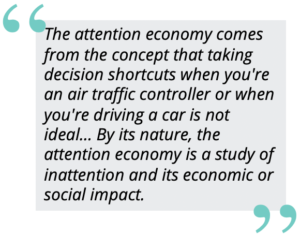
KNF: I’d like to give the attention economy a bit of background, if I may because it’s quite a buzzword now. Many people don’t really understand the context and its background. We all know that we live in this age of extreme distraction and our capacity to process is very small. What happens is that humans make decision shortcuts, and give little thought to what it is to avoid information overload. They give little thought to researching every single thing that comes past the desk.
The attention economy comes from the concept that taking decision shortcuts when you’re an air traffic controller or when you’re driving a car is not ideal. I think the study of information overload started during the World War II era. What impact does that have on our economic and social systems?
By its nature, the attention economy is a study of inattention and its economic or social impact. And, I often say, “Let’s just face it, team. We’re in marketing. It’s not the same. You’re not going to die, but we all know that clutter and noise are causing significant inattention in our industry and it costing advertisers money.” So that’s the context of the attention economy today.
Essentially, we want to understand not only the cause of inattention, the consequences of inattention but also some ethical solutions to correct it. I just want to emphasize that, because it’s really important to me. The nature of the term attention economy can conjure up a social dilemma and dark corners. What we’re interested in doing is actually saying, “Where are we at in our ecosystem and how have we gotten here, where there’s no trust, no transparency?” Advertising is difficult enough, but when viewers want to block you, it’s harder to understand how can we actually improve the system and move towards essentially a currency, which is quality-based. That’s what’s missing in the market today.
That’s the context of the attention economy. The book goes a bit deeper because it talks about “how did we get here?” Well, the world exploded in the new media space really fast. There was this whole blitz scaling piece where one minute I was at a newsagent and everyone was subscribing the old-fashioned way and the next minute there are three trillion users of a platform that none of us had heard of the year before.
The book also talks about that and the implications for how there’s this really interesting 15 years where there were not a lot of standards or regulations and the industry is trying to catch up and what does that mean when measurement is not independent? Where should we move towards? Right to the end, looking at what does brand growth mean in the future? Given we’re more driven by algorithmic editors than journalistic editors now, what does that actually mean for our choice sets? What does that mean for how we buy brands and how we’re exposed to them? It’s quite a broad-based book with a lot of the research that we’ve done more recently using the technology that we have to understand some of the mediating variables about the cause of inattention.
MB: Excellent. Well, to follow up with that, a two-part question. How should we be measuring media today and what are the core metrics should we be tracking if you’re just getting started from shifting from impressions to attention?
KNF: One section in the book talks about currencies. What I do acknowledge is that a currency change is not an overnight effort. I mean, you guys are US, so to get it to move it from nothing to your American dollar, I think that we’re trading on gold or whatever it was to get it to the first American dollar, took 20 years. I feel like we all just have to take stock that this is not an overnight thing.
My job is to help people understand what we can strive for. I do believe that eventually, attention could be a currency because impressions are flawed. I don’t think we’re there yet. And there are steps to take.
Even more recently, everyone’s talking about the attention CPM, which we do as well. We put a beta trial of our SES platform, our attention platform out, and it’s now in 21 countries. We got feedback back from that, and the data that we can see suggests that CPM and performance are not linear. The last thing you want to do is start calling out an attention CPM, knowing that CPMs are not equal either.
Two similar socials might have very similar CPMs on the surface, but, below the surface, their attention numbers are quite different. So we can’t just go, “Let’s just jump on a measure that we know CPMs don’t equate to value.” There’s a little bit more work to do with that. Albeit, I think that could be where we end up in the end, but for us, where I see attention at the moment is not literally kicking out what you’ve got, right?
All the agencies have spent millions and millions of dollars on their optimizers. And so, I think reach, and frequency will stay for a while. I think attention will be a supplementary layer, which is what we’re being told, and that’s our agenda. So we were suggesting that the data we provide or any attention data that are credibly collected should be used as a weighting layer against net reach. 
We’ve introduced this concept of attention-adjusted net reach, which is essentially saying, “You buy against a thousand sets of eyeballs. That’s your reach number.” But actually what we do know is that there’s very, potentially half of them, let’s just be fair, half of them even get to see it. So, adjust it down based on this data, then populate that back into your systems and recalculate your GRPs and your tops and OTS from there.
Let’s take a step back, integrate attention data as a quality layer from a weighted perspective. Then, let’s start to integrate CPMs into that, because the market will start to correct itself just like unit pricing. Pricing is the concept that when you walk into a store all the cans are on the shelf and it gives you a liter price, a per liter price. And the reason that works is that a 300 mil Pepsi in terms of its initial price point is not that different from a 300 mil Coke. That’s what we need to get to.
We need to make sure that the CPMs, or the cost of the can, are relative. So then you can use the unit pricing from there. That’s how I see the evolution of it. Start at the net reach level with an attention-adjusted net rate, then integrate CPMs and adjust your mix and your budgeting from there.
MB: I want to get into 5-10 years down the road. Does technology like yours work better for TV or mobile or is it roughly the same for both? As more spend shifts to digital, is that just going to naturally bring this measurement to the forefront, or is it, if it’s already good for both, could it happen sooner? 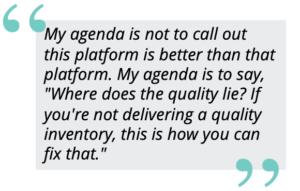
KNF: That’s the beauty of being researchers first, commercializing it second. We’ve gone into the market building some technology. We’re a combination of three different things. We’re a combination of MOAT, in that we collect device-based data. We collect scroll velocity, volume, sound on/off, and volume, phone orientation, pixels, spatial clutter, and all that sort of stuff. We’re a combination of Zoom, in essence, that we take facial footage while you’re viewing the platform. That is what goes through our machine learning models. The third piece is we’re also a video player. We can actually pull ads out of Facebook for example, and replace them or overlay them with ads.
We built this really, really deep tech for the sole purpose of being 100% fair to all platforms. My agenda is not to call out this platform is better than that platform. My agenda is to say, “Where does the quality lie? If you’re not delivering a quality inventory, this is how you can fix that.” To the credit of many of the socials, that’s where they’re seeing their future.
But my point was, you asked me, is it better in one form or another? A big part of this fairness was to make sure that cross-platform attention measurement was absolutely as fair as absolutely to both. The last thing you want to do, and this is the problem I see in a lot of the research that’s delivered, is that you can’t compare methods. So, therefore, one isn’t equal to the other and then one suffers. The short answer is we’ve built the technology where we can actually put remotely managed devices in front of TVs that film people and the TV content is streamed to the television set.
Similarly, the mobile is designed around the same context in that it is, are you looking straight at the ad or in the case of TV, are you looking straight at the screen? The second piece is passive. Passive attention is you’re near the ad meaning you’re looking on the screen, but not at the ad. In the context of TV, it’s when you’re around the ad, but you’re not looking straight at it. You’re sitting there, but it can still tell that you’re around here, and non-attention is the same for both, that there is no way you’re looking at the ad at all, because you are either out of the room or your phone can’t pick up that your face is detected.
I think the short answer is, that’s been our agenda. We’re fussy about how similar the models are across platforms so that there’s no bias towards any platform at all.
MB: Excellent. As we look forward 5-10 years, we just started a new decade of this. When we’re near 2030, how are we going to be measuring media?
KNF: I still think the same. As I said, I think the standards will be adjusted, but I don’t think we’re going to move away from the same systems that we have. I just think they’ll be amplified. I know that’s what our business is called, but I think technically the systems will be amplified, and data will come in. Third-party, independent data will come in as a check balance. So, I don’t think it’s going to change. That’s my thinking. If you ask me in 10 years what the next 5 to 10 years will look like, I don’t think the currency will change significantly at its core. We’re all aware that it needs to change. We’re also all aware that there have to be some amendments to what we’re doing to drive greater effectiveness, not efficiency, but effectiveness for the customers or the advertisers. At the end of the day, we have to keep them surviving for this industry to survive itself.
I look at our whole ecosystem starting to crank up and understand that quality delivery renders quality viewing, which gives higher CPMs. I’d suggest reading Joe Marchese’s work. Joe Marchese was the president of Fox ad sales. But before that, he owned TrueX and sold it to News Corp for quite a lot of money. He’s an accomplished media guy and now runs a VC fund called Attention Capital, but he inspires me because he really talks about this ethical play really deeply. It’s quite a thing for him. I really align with that, that we can’t just fix one part and not expect the other to fail. We’ve got to really pull up the entire ecosystem and away from any social dilemma negativity.
MB: Definitely. One area that our team focuses on is cross-screen planning and execution with a big focus on getting traditional TV buyers and planners to think about digital, whether it’s social or CTV or a mobile desktop and vice versa, getting digital-first buyers to understand TV. We’ve gotten around the reach. I think people accept that and the different sources. Attention and effectiveness still seem to be a challenge. If you’re a traditional TV buyer, thinking you may only get two seconds of attention on a Facebook ad, it’s kind of hard to digest and vice versa. If you’re digital-first, you just think we should make different creative works in that environment. We look at this as a missing piece.
Do you see adding attention-based metrics, even if as a secondary measure, accelerating the transition cross-screen planning and buying? 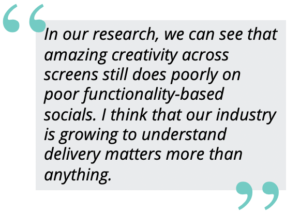
KNF: Yes, because hearing you say you have to be a better creative is the wrong answer to advertisers. You didn’t say that, but that’s the typical response. My job is to let people know that the media’s functionality is what’s causing the inattention or the two seconds rather than improving creativity.
In our research, we can see that amazing creativity across screens still does poorly on poor functionality-based socials. I think that our industry is growing to understand delivery matters more than anything. We’re seeing a shift. A year ago I decided to be a part of the solution rather than just be a research organization that delivers findings.
Findings don’t change stuff, application does. Even with what we’re seeing with this platform delivery we built, having had 19 platforms signed up to MVP, they’re all asking, A. “what can we do to improve delivery?” meaning what are the mediating variables, and then B. “can we get our data considered because we believe that we’re quality delivery?”
I think the opposite. I think it’s good news and bad news for TV, in that there’s going to be more competition for the quality play. At the moment TV, owns that. I think that advertisers and agencies are starting to realize that the headlines for TV had just been off the charts in positivity while the headlines for the socials have been off the charts in negativity.
I think it’s a good opportunity for TV to capitalize right now. However, I do think they’ve got to watch the tower because I honestly believe that everyone is starting to get that you’ve got to make sure that these ads are delivered well so that there hasn’t affected the other end in an advertising-funded, supported system. Measurement of effectiveness is getting so much more complex. We’re not just doing recall anymore.
Today, we’re complex and better so I think it’s changing the ecosystem at the moment. I think it’s exciting for TV right now. I think they just have to keep innovating, keep working in partnerships to get technology adapted, to compete with those that have superhuman computers at the other end.
MB: Absolutely. And you were recently nominated for Mediatel’s Media Leader of The Year for technology, new media. Obviously, a great honor. What part of your work do you think is resonating to garner this attention?
KNF: I was genuinely honored by that. I think it’s about the shift from findings to applications. I’ve always had a profile as an academic, which has been fantastic; I’m quite fortunate in that way. It gets you up the system, and you get to a professor role. I’ve been a professor now for five years, but what it doesn’t do is get into the nuts and bolts of how you change a media buy to improve your advertiser outcomes.
I was nominated as a finalist because of the application in the industry. We’re getting a good amount of feedback that suggests, as simple as it is, its attention adjusted net reach is actually making a difference and what it is doing is pushing a lot more cross-media buying because if you start to reduce your gross reach by a large multiplier, it just means that you have to buy across various media platforms.
MB: That’s great. One other area I wanted to ask you about is the Attention Council. Who’s involved, and what’s the goal?
KNF: It started with a bunch of like-minded attention vendors. There aren’t many of us globally. Having a beer in London about a year and a half ago, saying, “We all understand what we’re trying to do here and we need to drive a category, which is on the precipice. We need to just nudge it.”
Using our profiles, we called upon this council and said, “Leaders in the industry who are already on the same page, let’s join a group and come together to talk about fostering a category in the right direction” That’s where it all started, but since then industry folks have come in and taken over.
When I say industry folk, advertisers, in particular, they’re talking about incorporating media owners. There’s been a year and a half of setting an agenda, and then the board is changing. Advertisers are coming through, and the next wave will drive it even more deeply. So, its agenda is to drive awareness of the importance of attention metrics. Its agenda is to ensure that it’s done ethically and sort of rally the troops.
MB: Great. Well, we’ll get you out of here with one more question. We ask everybody if you could get your whole team to read one book right now, what would it be and why?
KNF: I’m a bit biased but, we’re going through significant scale-up pain and excitement at the same time. So we’re heading into an exciting year ourselves. And one book that changed my life, I think, was a book called That Will Never Work by Marc Randolph. It talks about Marc Randolph, the co-founder and original CEO of Netflix. His fame has subsidized with the current CEO. We’re about to do another planning day ao I’ll be taking pieces from that.
But the way that they went about forging a category is super encouraging. We are leaders in a category that’s right on the edge. And I feel, some of the steps that they did take, you know fail fast, all that kind of stuff. Get your MVP out there, then create change, then get another one out there, and then create change. I love it so, I highly recommend that book.
MB: Add that to the list. Well, I’ve really enjoyed the talk and I know our community is going to love the conversation and just really appreciate your time.
KNF: Thanks. It was fun.
See the rest of the Screen Wars Thought Leader Interview series here!
Professor Karen Nelson-Field is Founder and CEO of Amplified Intelligence, and Professor of Media Innovation at The University of Adelaide. Karen is a globally acclaimed researcher in media science, is a regular speaker on the major circuits, including Cannes and SXSW, and has secured research funding from some of the world’s largest advertisers. Her first book, Viral Marketing: the science of sharing,set the record straight on hunting for ‘viral success’. Her most recent book The Attention Economy and How Media Works explains the stark reality of human attention processing in advertising. Her research has been noted in The New York Times, Bloomberg Business, CNBC, Forbes, Wall Street National, Huffington Post, Contagious and The Drum, and she has been a regular media writer for the Australian Financial Review. Karen’s commercial work combines tech and innovative methodological design to look closely at attention metrics in a disrupting digital economy.
Cross Screen Media is a marketing analytics and software company empowering marketers to plan, activate, and measure Connected TV and audience-driven Linear TV advertising at the local level. Our closed-loop solutions help brands, agencies, and networks succeed in the Convergent TV space. For more information, visit CrossScreenMedia.com.


